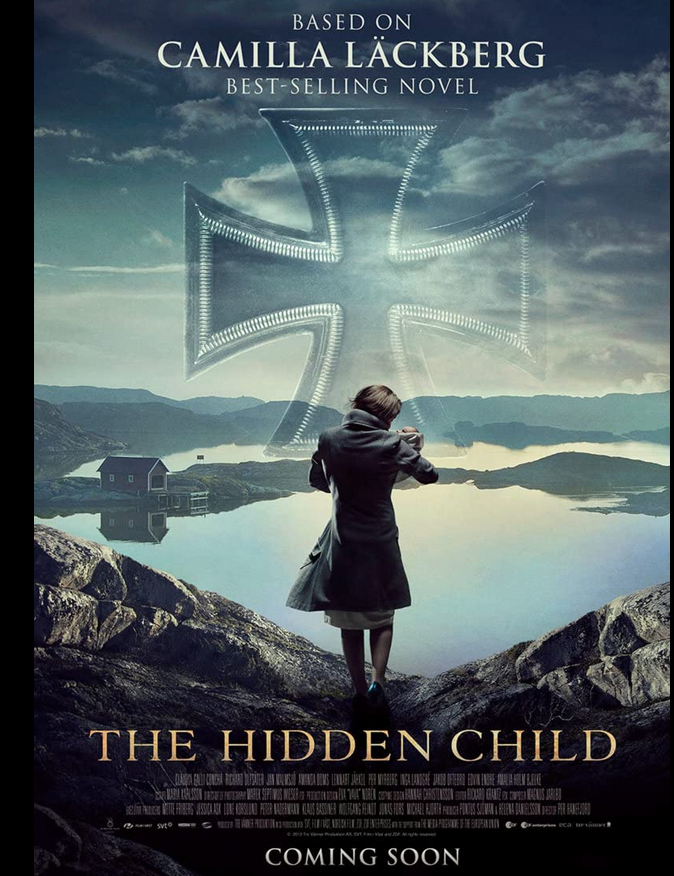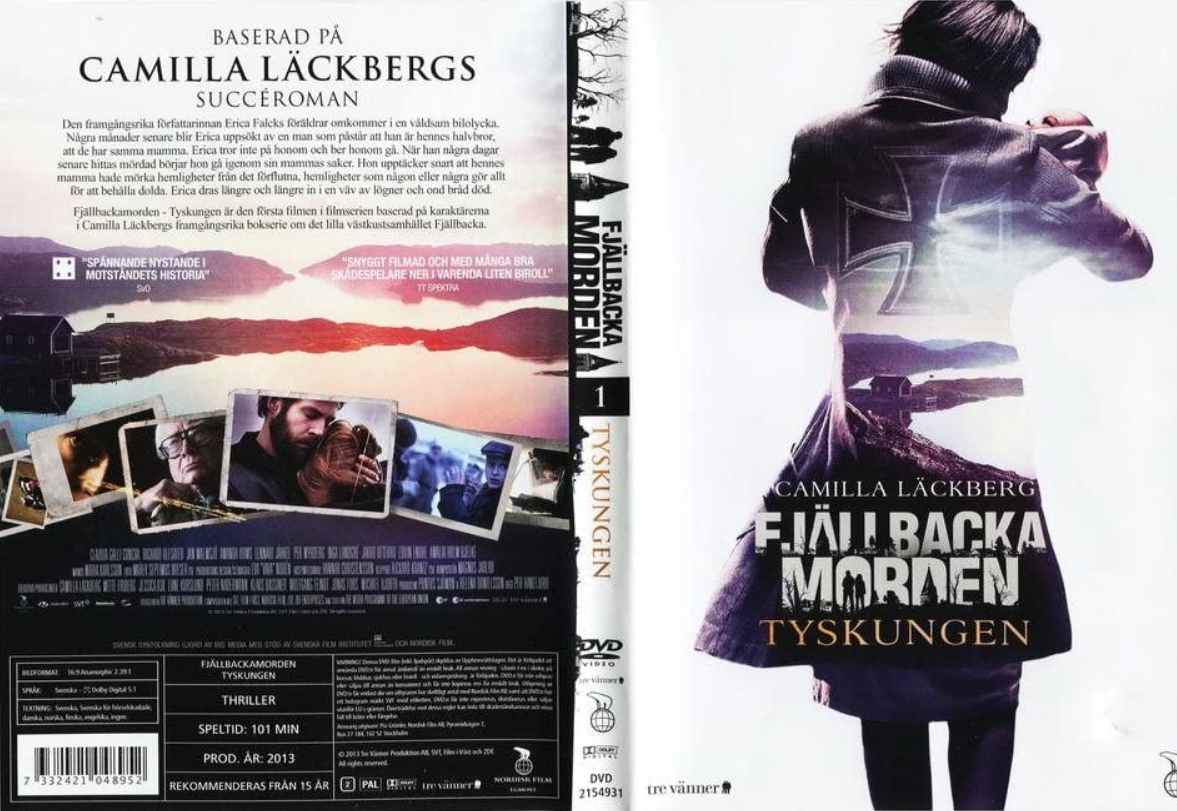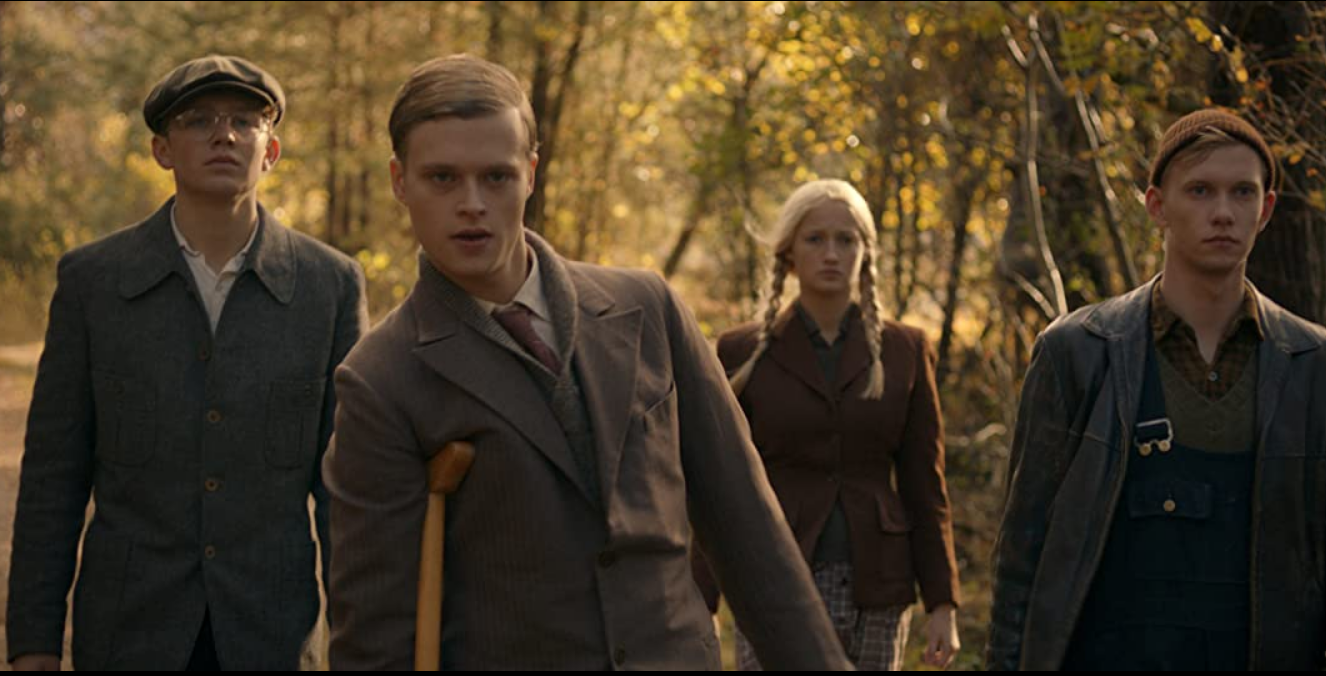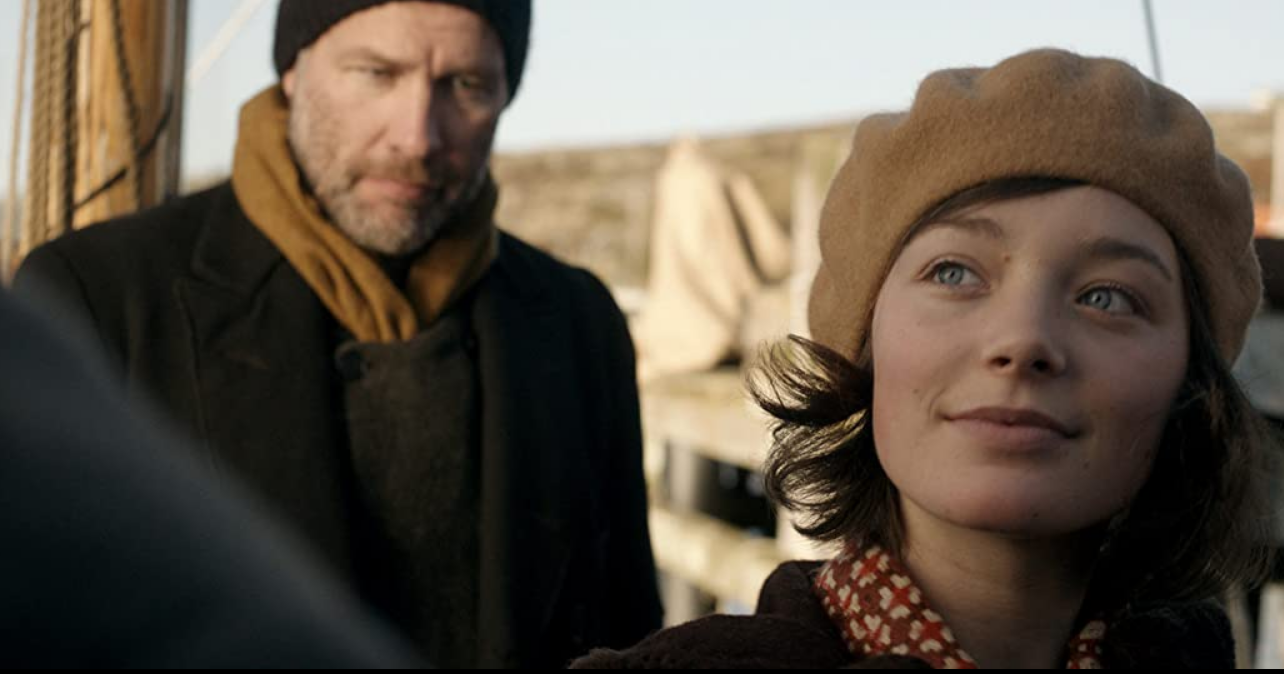[ENG/ESP] The Hidden Child is the first film adaptation of a book by Camilla Läckberg. / Las Huellas Imborrables es la primera adaptación cinematográfica de un libro de Camilla Läckberg.[REVIEW/RESEÑA]

Hello, friends #hivers!
Scandinavian literature (especially Swedish and Danish) has presented us in recent years a remarkable production of new writers among which emerge with a certain leadership Stieg Larsson, author of the celebrated (and unfinished) Millennium series, completed after his death improvised by his colleague David Lagercrantz, who, on the basis of manuscripts left by Larsson himself, added three more books to complete the saga, and Henning Mankell, author of the well-known saga with the commissioner Kurt Wallander, taken to the cinema on some occasions by the remarkable Kenneth Branagh and some other Scandinavian series for TV.
If we must go back a little further we must refer to Peter Høeg, one of the precursors of the Swedish "noir" with his wonderful "Smila's Sense of Snow".

Hola, amigos #hivers!
La literatura escandinava (especialmente sueca y danesa) nos ha presentado en los últimos años una notable producción de nuevos escritores entre los cuáles emergen con un cierto liderazgo Stieg Larsson, autor de la celebrada (e inconclusa) serie Millenium, completada después de su muerte improvisa por su colega David Lagercrantz, quien sobre la base de manuscritos dejados por el propio Larsson agrega tres libros más para completar la saga y Henning Mankell autor de la conocida saga con el comisario Kurt Wallander, llevada al cine en algunas ocasiones por el notable Kenneth Branagh y alguna que otra serie escandinava para la TV.
Si debemos remontarnos un poco más atrás debemos referirnos a Peter Høeg, uno de los precursores del "noir" sueco con su estupenda "La señorita Smila y su especial percepción de la nieve.".

But today I want to refer to the film adaptation, very well done on the other hand, of one of the successors of Mankell and Larsson: Camilla Läckberg, writer of the same nationality and heiress of that particular style.
The The Hidden Child is the film adaptation of Camilla Läckberg's fifth novel (Tyskungen in French and The Hidden Child in English).
The plot is based on a story of mysterious crimes and the search for the truth that Erica, the main protagonist, carries out after the death of her parents.
Pero hoy me quiero referir a la adaptación cinematográfica, muy bien lograda por otro lado, de una de los sucesore/as de Mankell y Larsson: Camilla Läckberg escritora de la misma nacionalidad y heredera de ese estilo tan particular.
Las Huellas Imborrables es la adaptación cinematográfica de la quinta novela de Camilla Läckberg (Tyskungen en surco y The Hidden Child en la versión inglesa).
El argumento se basa en una historia de misteriosos crímenes y la búsqueda de la verdad que lleva adelante Erica, la protagonista principal, después del fallecimiento de sus padres.

The story starts with the first scene when the writer Erica Falck (a kind of alter ego of the author of the book) and her husband, the commissioner Patrik Hedström, visit their first daughter in the hospital.
Erica's parents are also part of the family entourage that visits the little girl, but when they return home they are involved in a car accident and die.
The curious thing about this beginning is that it is very different from the Scandinavian films we are used to seeing: calm, quiet, with a slow and linear plot, sometimes even a bit gloomy (in all senses, not only metaphorically, since the sunlight in Scandinavia lasts only a few hours a day).
And it is a particular beginning because the accident is twofold. First the car runs off the road and they are badly injured. And immediately they are hit again and then they die. As if there was something premeditated in the action. At least that is the first impression that accompanies the viewer.
There is a time jump in the plot that picks up six months later when Erica and her husband go to her parents' house to get the deed to the house as they plan to sell it and transfer. While she is getting things settled a man who calls himself Göran Berger shows up asking about her mother.
When Erica tells him that she died in an accident six months ago, he formally introduces himself and confesses that he is actually looking for her mother, since Elsy (Erica's mother's name) confessed to him when she was 16 years old that she was her biological mother.
In the midst of the shock of this news, Erica tells her to leave and is left alone to think about what happened.
She starts digging through old family photo albums to see if she can find or identify her half-brother when the local police chief calls to tell her that the person (who had introduced himself as her brother) has been found dead in a bathtub at the hotel where he was staying. The police had been able to contact Erica because she was the last number listed in Göran Berger's phone book. So he asked her to come to the morgue to identify him.
After DNA verification, the stranger's words take on a disconcerting and terrifying truth: he is (or was) indeed her brother and she had thrown him out of her house without further explanation.
The sense of remorse and guilt begins to invade her, amidst increasingly dark and distressing landscapes, presentiments and thoughts.
In the investigation Erica discovers several elements and characters linked to her mother's life during the Swedish resistance in the middle of World War II, patriots, traitors, stories of love and disenchantment.
In a constant series of flashbacks that go back and forth in time during the last half century, the story of many characters committed and linked to her mother's life is unraveled.
In the end Erica visits her mother's grave and discovers many aspects of her life that had been ignored until now, while she and her wife Patrik decide to move permanently and start a life in Fjällbacka. Where they had thought of moving to after the death of their parents when everything had started with the unexpected visit of her brother.

La historia arranca con el primer golpe de escena cuando la escritora Erica Falck (una especie de alter ego de la autora del libro) junto a su esposo el comisario Patrik Hedström visitan a su primera hija en el hospital.
Hacen parte de la comitiva familiar que visita a la pequeña también los padres de Erica, quien al volver a su casa sufren un accidente automovilístico y mueren.
Lo curioso de este inicio es que es muy distinto a las películas escandinavas que estamos habituados a ver: calmas, tranquilas, con un argumento pausado y lineal, a veces hasta un poco sombrío (en todos los sentidos no solo el metafórico ya que la luz solar en toda Escandinavia dura pocas horas al dia).
Y es un inicio particular porque el accidente es doble. Primero el auto de sale de la carretera y quedan malheridos. E inmediatamente son embestidos de nuevo y entonces sì mueren. Como si hubiera algo de premeditado en la acción. Al menos es la primera impresión que acompaña al espectador.
Se produce un salto temporal en la trama que se reanuda seis meses después cuando Erica y su esposo van a la casa de sus padres a buscar la escritura de la casa ya que piensan venderla y transferirse. Mientras está acomodando las cosas se presenta un hombre que se hace llamar Göran Berger preguntando por su madre.
Cuando Erica le refiere que ha fallecido en un accidente hace seis meses éste presente se presenta formalmente y le confiesa que en realidad está buscando a su madre ya que Elsy (asi se llamaba la madre de Erica) le ha confesado cuando tenía 16 años que era su madre biológica.
En medio al shock que esta noticia le produce Erica le dice que se vaya y se queda sola pensando en lo sucedido.
Comienza a investigar entre viejos álbumes de fotos familiares para ver si encuentra o identifica su medio hermano cuando el jefe de la policía local la llama para decirle que la persona (que se había presentado como su hermano) ha sido encontrada muerta dentro de una tina en el hotel que se hospedaba. La policía había podido contactar a Erica porque era el último número que aparecía en la agenda telefónica de Göran Berger. De esta manera le pide que vaya a la morgue a identificarlo.
Hecha la verificación con el ADN las palabras del desconocido adquieren una desconcertante y terrificante verdad: es (o era) efectivamente su hermano y ella lo había echado de su casa sin escuchar mayores explicaciones.
El sentido del remordimiento y culpa comienza a invadirla, en medio de paisajes, presentimientos y pensamientos cada vez más sombríos y angustiantes.
En la investigación Erica descubre varios elementos y personajes ligados a la vida de su madre durante la resistencia sueca en plena Segunda Guerra Mundial, patriotas, traidores, historias de amores y desencantos.
En una constante de flaskbacks que van adelante y atrás en el tiempo durante el último medio siglo se va desgranando la historia de muchos personajes comprometidos y vinculados con la vida de su madre.
Al final Erica visita la tumba de su madre descubriendo muchos aspectos de su vida ignorados hasta el presente, mientras que decide con su esposa Patrik mudarse definitivamente y comenzar una vida en Fjällbacka. Donde habían pensado de transferirse después de la muerte de sus padres cuando todo había comenzado con la imprevista visita de su hermano.

Claudia Galli Concha
Richard Ulfsäter
Amalia Holm
Jakob Oftebro
Per Myrberg
Jan Malmsjö
Edvin Endre
Anders Nyström
Axel Myrberg
Inga Landgré
Fanny Klefelt
Espen Skjønberg
Sigmund Hovind
Björn Andersson
Pamela Cortes Bruna
Lennart Jähkel

The suspense thriller has generally been a film genre much maltreated by critics. Sometimes rightly so because of the use and abuse that has been made of it. Other times, on the other hand, the product has been worthy and deserves to be highlighted. As in this case.
The plot is quite linear with the book and presents the duality of two absolutely opposite poles that respond to two forces: those who want to bring to light secrets that are not only passionate or sentimental and those who do not want to unearth old stories of betrayal, spies, pseudo war heroes who are not such and other old memories of a war that many prefer to forget.
There are many loose ends that are untied and then knotted again, giving the plot a constant interest where the psychological factor always prevails.
It seems as if a mental compass was oscillating in the conscience of the characters, not knowing where to position themselves, not knowing whether to settle definitively in the north of the mind or to look for other alternatives.
The mechanism of doubt is present throughout the film. Perhaps it is a genre (or a subgenre) of film that we are not used to seeing accustomed to Hollywood productions and the American market.
In a way it reminded me of Stieg Larsson's The Men Who Didn't Love Women , the first part of Millennium and the best of the trilogy. He too was a master at generating the mechanism of doubt.
And in that sense The Indelible Footprints gives the best of itself. Recommended.

El thriller de suspenso generalmente ha sido un género cinematográfico muy maltratado por la crítica. A veces con razón por el uso y abuso que se ha hecho de él. Otras veces en cambio el producto ha sido digno y merece destacarlo. Como es este caso.
La trama es bastante lineal con el libro y presenta la dualidad de dos polos absolutamente opuestos que responden a dos fuerzas: aquellas que quieren llevar a la luz secretos que no son solo pasionales o sentimentales y aquellas que no quieren desenterrar viejas historias de traiciones, espías, pseudos héroes de guerra que no lo son tales y otros viejos recuerdos de una guerra que muchos prefieren olvidar.
Hay muchos cabos que se van desatando y luego se vuelven a anudar dando a la trama un constante interés donde prevalece siempre el factor psicológico.
Pareciera como que una brújula mental oscilara en la conciencia de los personajes sin saber en que punto posicionarse, sin saber si asentarse definitivamente en el norte de la mente o buscar otras alternativas.
El mecanismo de la duda está presente en toda la película. Tal vez sea un género (o un subgénero) cinematográfico que no estamos acostumbrados a ver habituados a las producciones hollywodianas y al mercado americano.
En cierto modo me hizo recordar a Los hombres que no amaban a las mujeres de Stieg Larsson , la primera parte de Millennium y la mejor de la trilogía. También él era un maestro en eso de generar el mecanismo de la duda.
Y en ese sentido Las Huellas Imborrables da lo mejor de si misma. Recomendada.












Comments